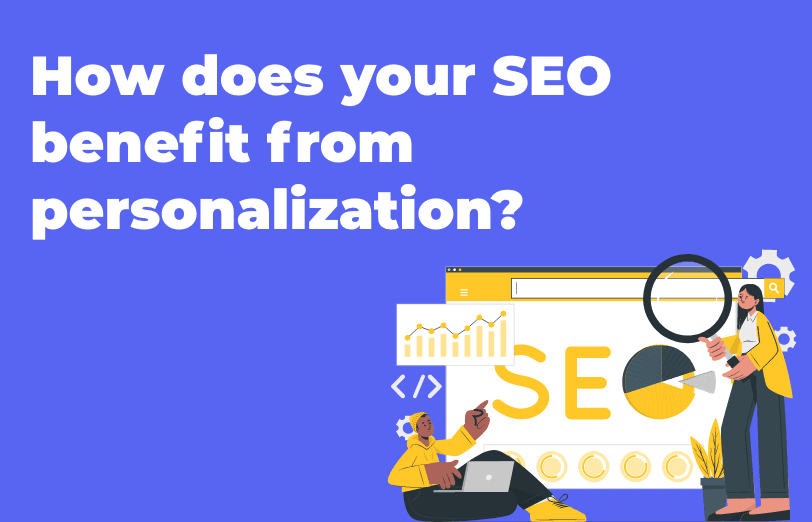How does your SEO benefit from personalization?
Published: 22 September 2022

Personalization is currently one of the top marketing strategies and one of the most effective ones. People will visit your website through different means, channels, touchpoints, and mediums. It is essential to grab their attention at each and every entry point. This is something that can be done through Sitecore.
Sitecore offers hyper-personalization which is different and better than the traditional or conventional ways of personalization that used to be done before in marketing.
The goal of personalization is to ensure that the visitor clicks on the CTA and converts into a customer. Through personalization, optimization of each website page is possible allowing the business to define user journeys, and routes and identify customer behavioral patterns.
Once these patterns are identified, the customers can be given personalized experiences through targeted, unique user journeys and offers.
What things to be careful about for SEO?
- Page Speed
- Cloaking
- Duplication
When building personalized content and generating such unique experiences, Sitecore focuses on making sure that it addresses potential challenges and is prepared for the things that could go wrong. There are several components and elements that could become a hindrance to the website's performance. Let us see what those are:
Page Speed
The page speed of a website is actually one of the ranking factors when it comes to any website. Search engines keep this factor in mind when checking the website's performance.
The longer it takes the page to load, the farther your users will be driven away. The user attention span is very low and they get bored even with a slow loading website. The longer it takes for your website to load, the quicker you are going to lose visitors and website traffic.
When you are generating personalized content onto your website, you need to have multiple scripts running in the background. This will fatigue the servers and make it harder for them to quickly load the pages. This could be one of the causes of slow website loading.
Cloaking
Cloaking by definition means “the practice of presenting different pieces of content or URLs to search engines and users.” This is actually a major violation of the guidelines presented by Google. This risky practice can actually damage your search engine rankings.
But, another point on hand is that for personalization, you will have multiple versions and variants of the same piece of content. You will have different versions to push the content to different segments of your targeted audience.
One of the best ways to avoid this practice and at the same time carry on with your personalization strategy is to implement canonical links.
Duplication
Another major usage of implementing canonical links is that you can avoid duplication of your content. Often when you are working on a personalization strategy, duplication occurs. While it is not actually against the guidelines provided by the search engine, it can cause keyword cannibalization.
Keyword cannibalization happens when two duplicate or nearly duplicate pages with content optimized for the same terms are fighting to rank at the same space. It is a good idea to implement canonical tags to avoid any such issues before they even occur.
How does Sitecore handle personalization and SEO?
When it comes to personalization and its impact on SEO, Sitecore takes it very seriously to ensure that the impact is more positive than negative.
Page Loading Speed
According to Google PageSpeed Insights, the time to load LCP (Largest Contentful Paint) should be at or below 2.5 seconds only. How is LCP defined? It is the time it takes to measure the perceived load speed or when the main content on a page is loaded.
We know that due to personalization, content with different versions will be submitted, which is one of the causes of the slow loading speed. When it comes to Sitecore, they store the content on the server side so that it does not actually weigh on the page.
Their Content Delivery Network (CDN) is the place where personalization actually happens. When the page loads, immediately the JavaScript starts its work of injecting the personalized content for allowing Google to crawl it.
It is very common to apply third-party rules when you are just getting started with personalization. You do not want to inflate the load times or provide a poor experience to the users. Sitecore CDP helps you to ensure that your website is optimized with a quicker load time.
Cloaking and Duplication
Sitecore does not change the purpose of the page or the content or even the meaning of the content. They only personalize the content on a component and element level. This will ensure that the base level content is not changed or tampered with.
The aim is to index on Google and also to avoid competing with own content. Black-hat SEO tactics will only lead to extremely poor results and your business does not need that.
What are the benefits to your SEO due to personalization?
- You can target a visitor’s specific questions and queries no matter where they are in the funnel.
- The visitors can enter your website via different, multiple entry points.
- You can improve the customer experience and at the same time rank your website through different versions of content and pages.
- A good website will reduce the bounce rate and increase the time spent on the website.
Conclusion
One of the most powerful platforms when it comes to personalization is Sitecore CDP. The Sitecore Customer Data Platform (CDP) doesn’t just offer traditional personalization but hyper-personalization, all the while ensuring that it causes minimum to no impact on your SEO efforts.
Any personalization strategy is going to come with its pros and cons and it is better to implement it while also considering how to address the challenges rather than not doing personalization.

Maulik Dudharejia - Co-Founder & CMO - ADDACT
Sitecore MVP 3X || Digital Transformation Strategist || Marketer
Maulik Dudharejia is a visionary author, co-founder, Chief Marketing Officer, and a digital transformation expert with over 12+ years' of experience. He leverages industry certifications to translate complex tech concepts into engaging writing. His areas of expertise include Sitecore, IoT, and IT Service Management. Maulik offers valuable insights and strategies to help readers navigate the evolving tech landscape.
